
Unaffordable Education in the New India
One of the few aspects of the Indian development project that is supposed to have seen some recent success is education. Enrolment has increased significantly in school and higher education, and the gender gap in enrolment has reduced up to secondary education (after which it still remains high). However, the Report of the NSSO’s 75th Round survey of “Household Social Consumption of Education in India” conducted from July 2017 to June 2018 provides some very disturbing results. Essentially, this expansion in education has involved increasingly burdening households for the payment, creating a situation in which education beyond the secondary level is essentially unaffordable for most working people, and even school education involves costs for families that can be very high.
Table 1: Household spending on education per student
(Rs per year)
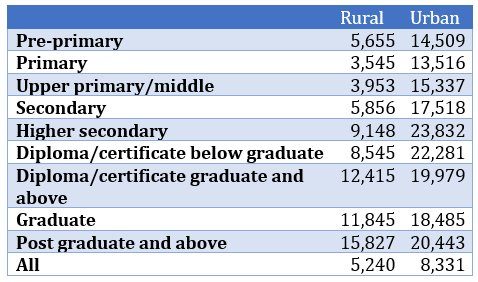
Table 1 provides an indication of just how much is actually being spent by households on education at different levels. Several points of interest emerge from this. First, pre-primary education is clearly quite expensive. Thereafter, the sharp increase in costs comes up at the secondary level, when spending nearly doubles in rural areas. Tertiary education is really quite expensive, with even rural areas indicating high levels of spending on this.
Why are households having to shell out so much when a significant amount of enrolment is still in public institutions which should be much more accessible to all? The Right to Education Act, 2009, specified that school education up to the age of 14 years would be free and compulsory, and the spirit of that legislation clearly required that the costs of elementary schooling would be borne by the state. Yet, as Figure 1 indicates, only a minority of students receive free education, and less than a quarter in urban areas. And there are also other costs associated with schooling—such as textbooks, uniforms, transport—which also add to the financial burden on households. And in this respect, very few students received any assistance.
Figure 1
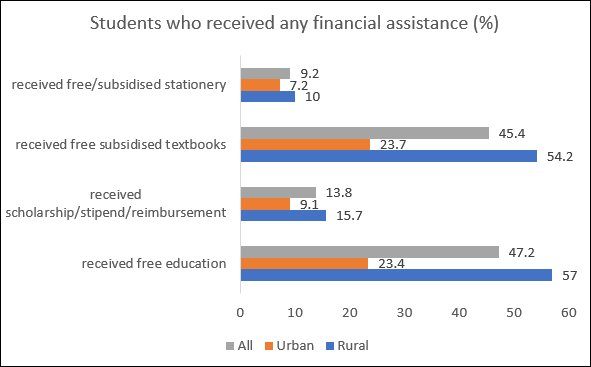
Figure 2
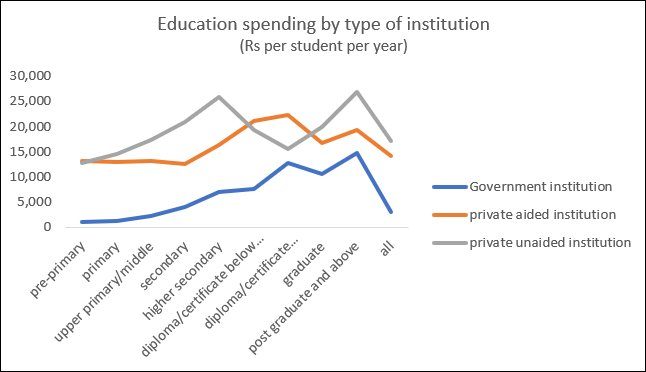
Further, it turns out that even for government institutions, costs rise sharply with the level of education on offer. The difference in spending on government institutions compared to private ones (both aided and unaided) is very large until secondary education as expenses are low for government schools until that point. But thereafter, the gap narrows, and by the graduate and post-graduate levels there is not much difference between them and private government-aided institutions. It is striking that for private unaided institutions, expenses are very high for higher secondary schooling, almost as high as post-graduate. Essentially this means that not just the poor but even middle classes are effectively squeezed out of education beyond secondary schooling. And of course gender gaps grow after this points as well, as families are more reluctant to pay so much for educating girls.
To gauge just how much these expenses amount to, Table 2 present a simple calculation of the average monthly spending on education for two students, relative to the incomes of male workers revealed by the Periodic Labour Force Survey conducted over the same period 2017-18. (Bear in mind that women workers’ incomes are considerably lower.) The numbers are stark. In urban areas, nearly 40 per cent of a casual labourer’s wage (assuming 20 days of work per month, which could be an overestimate) would be required for the education of two children. The proportions are lower for rural wage workers, mainly because they are effectively excluded from seeking higher education for their children. The survey shows that only a small proportion of households attempted it and less than half of one per cent of casual workers rural households had anyone studying for a graduate degree. For rural casual labour households, average expenses per student increased from Rs 335 per month per student for secondary school, to Rs 576 for higher secondary, to more than Rs 12220 for diplomas, certificate and graduate courses.
Table 2: Monthly spending on education per student (Rs) relative to income
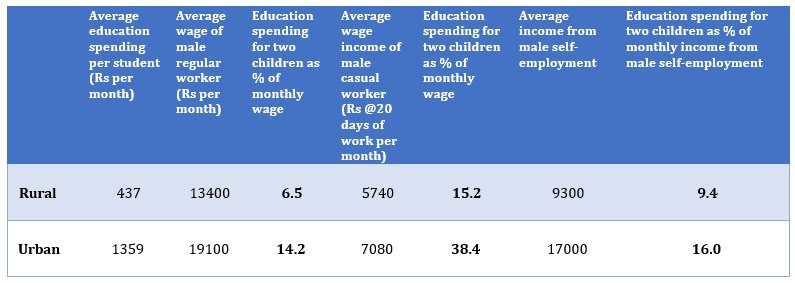
It is worth noting that the actual fees form only a part of the total expenses involved in education. Figure 3 indicates that the fees charged by an institution (including not just the tuition fees, but the examination fees, “development” fees and other charges levied by institutions) accounted for only 43 per cent of total education expenses in rural areas and 57 per cent in urban areas. Books and other material account for a substantial chunk of the money spent, especially in rural areas, and transport costs are significant everywhere. Interestingly, private tuition costs remain significant, suggesting that the quality of the institutionally provided learning is not good enough to meet the felt needs of students, despite the relatively high costs.
Figure 3
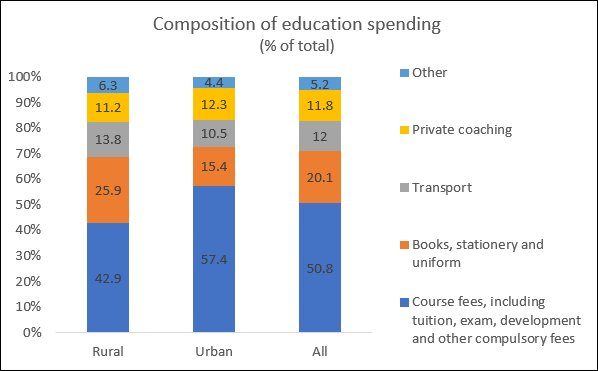
This suggests that the recent expansion in enrolment as come at a substantial cost to families, especially among the less well-off, who may have had to sell their few assets or take on debt simply to educate their children. These aspirations for betterment through education are increasingly risky given the terrible state of the job market. Unequal access and high personal costs involved in educating more of the young may well boomerang on society; both employment conditions and educational access need urgent policy action.
(This article was originally published in the Business Line on November 30, 2020)
